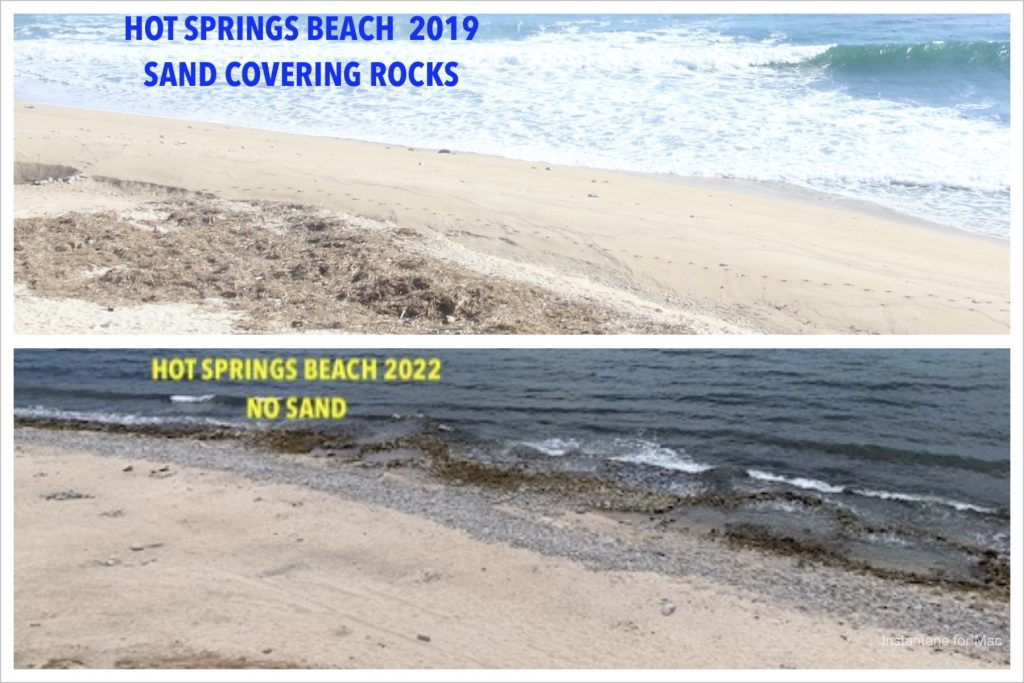Ocean beaches the world over change with the seasons and long-term weather events. La Ventana Bay beaches have these same dynamics but with less wave action. Beach sand comes and goes and is related to weather events and currents. Around La Ventana Bay, there will be years of no sand, and in other years there will be a significant amount of sand on the beaches. People who have spent their lives in La Ventana can testify to these decade-long changes. They might recall that 20 years ago, a beach had mostly rock boulders and just a small amount of sand near the bluff base. But they also remember when they first came here around 1987, the same beach was twice as wide as it is now. But no data was written down by anyone involving dates, amounts, etc.

Beach sand is replenished here basically in one way: When huge rain events (five or more inches in 24 hours) occur in the Cacachilas Mountains, flash floods happen in all the arroyos. The sediments that have loosened over the years wash out to sea, creating enormous sandy alluvial fans, spits, and sandbars at the mouth of those arroyos. When the prevailing northerly winds cause the current to move south around mid-October, all this sediment slowly moves onto the beaches in a southerly direction from the arroyos’ mouths. It continues to move throughout the years, eventually ending up on the dunes that face north at the south end of the bay. The dune system there is tens of thousands of years old. As we have all witnessed, the wind also blows the sand south on the beaches, mainly the El Norte winds. The sand is pushed onto the beach by the sea, and when it dries, the wind starts moving it south along the bluffs. The beaches become wider when large amounts of sediment are washed down the arroyos and into the sea. This natural process is called “beach replenishment.”
Therefore when there are extended periods of NO rain over a decade and no “flash floods” to dump sand into the sea, the beaches become narrower. And if the drought continues, the underlying rocks are exposed as the sand moves south, and there are no flash floods to replenish it from the north. The time it takes for the beaches to start losing sand and exposing rock is unknown because no one has done the needed monitoring. But during February 2022, someone dumped eight six-cubic-yard dump trucks of sediment over the rocks at the Punta Gorda Trailhead and “created” a beach for a few weeks until an “El Norte” occurred. This sediment was very different in color from the usual whiter beach sediment on our shores. Developers probably took it from one of the arroyos where builders mine it for construction, and it had a bit more brownish residue. Four weeks later, after a few El Nortes and high tides, sediment began showing up at the north end of Hot Springs Beach, and about a week later, it arrived on Rasta Beach. That’s the best data about the time it takes for sand to move south and provides an excellent opportunity to understand the sand movement.
The change in the beaches we see now started 10-12 years ago when the Cacachilas experienced a significant downpour, the last “flash flood” event to flush sand into the sea. At Sotol, the big arroyo just south of Hot Springs Beach, the alluvial fan extended around 45-50 more feet out into the sea than what it is today. About a year later, sand covered all the rocks south of Punta Gorda and Hot Springs Beaches. Today, where there is just a rocky shoreline, a sandy beach existed nine years ago. Venta Mar developers came up with the idea of building a resort there when they saw those beautiful white, sandy beaches. Had they made the resort, their customers would only have a boulder field to walk on today.
Another element is related to how sand removal occurs at our beaches. Once in a great while, when a hurricane develops south of Baja Sur and moves north into the Sea of Cortez, the giant waves associated with the cyclone will sometimes hit the beaches of La Ventana. These events are pretty rare, maybe every 20 years or so. But when the swell is huge and the tides high, the waves hit the bluffs, remove the sand from the beaches, and deposit it just off-shore. This sand slowly moves back onto the beach when normal conditions return. The recent development on the boundary of the Federal Zone at Rasta and Hot Springs was not there when the waves were pounding into the bluffs where these buildings are now. With the rising sea levels, the next hurricane may not be kind to these structures.